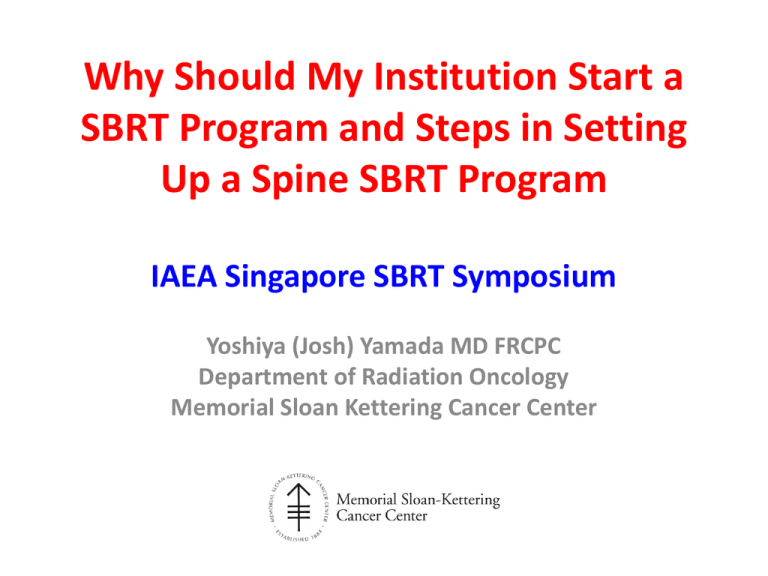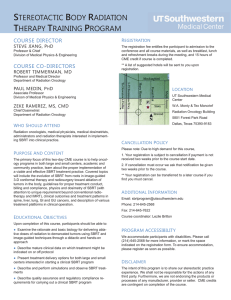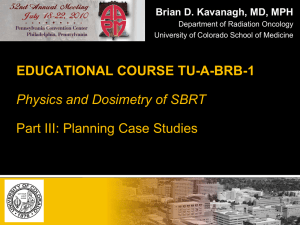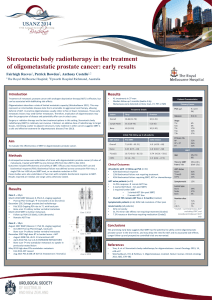Why Should My Institution Start a SBRT Program
advertisement

Why Should My Institution Start a SBRT Program and Steps in Setting Up a Spine SBRT Program IAEA Singapore SBRT Symposium Yoshiya (Josh) Yamada MD FRCPC Department of Radiation Oncology Memorial Sloan Kettering Cancer Center Disclosures • Varian Medical Systems Consultant • Institute for Medical Education Speakers Bureau CONVENTIONAL FRACTIONATION versus HYPOFRACTIONATION versus STEREOTACTIC BODY RADIOSURGERY (SBRT) SBRT Hypofractionation Conventional Number of fractions 1 5 ~35 45 Fraction Size >7 Gy 1.8-2.0 Gy Total Dose ~35-50 Gy ~50-75 Gy Biological Rationale Ablative?? N o r m a l t i s s u e s p a r i n g ~75-85 Gy Why SBRT? • SBRT is better (tumor control, toxicity) – Lung – Spine – Liver – Pancreas Benefits of Image Guided Therapy • Precision of treatment ( Uncertainty) – Increased confidence to: • Reduce: – Margins – Reduce normal tissue exposure – Toxicity • Biologic Effective Dose – Hypofractionate/ Single Fraction Treatment – Increase absolute dose • IMPROVE OUTCOMES 4D RT Week 1 • Motion management – Lung – Liver – Pancreas – Prostate Week 2 • Adaptive RT Week 3 Why SBRT? • SBRT is the only option: – Salvage RT: • Spine • H&N – Lung Why SBRT? • SBRT is more efficient: – Prostate 5 fractions vs 48 fractions • SBRT 30 minutes of Linac time vs non SBRT 10 minutes • SBRT 150 minutes of Linac time vs 480 minutes • Brachytherapy requires OR time – Pancreas 5 fractions vs 28 fractions • SBRT 150 minutes vs 280 minutes SBRT for Prostate Cancer Cost • 5 treatments vs. > 40 treatments • In US: SBRT $20,571 vs IMRT $36,837 CHEAPER Courtesy Pat Kupelian MD Why SBRT • SBRT takes less time: • Patients who live away from center: 1 week away vs onetwo months away – – – – Less impact on quality of life Less time away from home and family Less time away from work Less expense • Less interruption of chemotherapy treatment schedules Why SBRT • The demands of SBRT will raise the performance of department overall • SBRT requires robust QA program which can be applicable in other department activities – MD – Physics – Therapists The Ultimate Therapeutic Gain: Spine IGRT • Improving the therapeutic ratio: • Multimodality IGRT: The best of both worlds • Reduce toxicity: – Significant reduction in volume of volume sensitive toxicity – Reduce dose to dose sensitive toxicity • Improve tumor control: – Tumor dose is critical – Tumor control at ~ 90% level regardless of tumor phenotype or size – Greatest therapeutic gain may be for radioresistant disease Why SBRT Summary • Better tumor control – Hypofractionation, dose escalation • Less toxicity – Reduced margins, gating/adaptive RT • Faster – More efficient • Cheaper • Improve processes throughout department • Provide avenues to establish multidisciplinary relationships • Multidisciplinary academic collaborations Summary Spine radiosurgery is clinical proof of principle of the IGRT hypothesis ↓ Toxicity • IGRT ↓ normal tissue volumes and dose • Clinically significant toxicity is extremely rare ↑ Tumor control • High biologic impact of very high dose per fraction/single fraction radiation • Dose response relationship • Redefining traditional radiobiologic constructs of radiosensitivity Changed the management of spine tumors at MSKCC Summary • IGRT: • You can’t always get what you want… • But you get what you need! • With a little help from your friends! IGRT Quality Assurance is Critical Why SBRT • SBRT will provide mechanisms for multidisciplinary collaborations – Spine: Neurosurgery/Orthopedic Surgery/Interventional Radiology/Medical Oncology – Prostate: Urology-fiducial placement – Lung: Thoracic surgery/interventional radiology: • Fiducial placement – Liver: Fiducial placement: Interventional radiology, biopsy The Right Tools Tools • Be familiar actual with geometric uncertainties/capabilities of your equipment: – Gantry – Leaves – Table – Imaging uncertainty – Systematic and random errors The Right People • • • • • Radiation Oncologist Medical Physicist Medical Dosimetrist Radiation Therapist Other – Allied disciplines: Neurosurgery, Orthopedic surgery, Interventional Radiology – Nursing Getting Others Involved • Familiarize yourself with the medical evidence in all related disciplines • Encourage collaboration • Multidisciplinary management – Establish Multidisciplinary Treatment Protocols – Clinical Trials/Studies – Multidisciplinary clinics/joint patient evaluation/assessment Synergistic Academic Productivity • Take advantage of individual expertise • Coordinate efforts • Team approach – Group research goals – Common data collection ie MDASI – Common definitions ie NOMS – MSKCC spine service has over 20 peer reviewed publications in 2012 Learn from Others • Fellowship training/special extended training • Attend specific meetings/conferences • Spend time with experts – Multidisciplinary • Radiation Oncology • Medical Physics • Allied disciplines – Visit a high volume experienced center Learn From Yourself • • • • • Perform SBRT on specific protocols In house, regional or national studies Careful QA, chart review, toxicity assessment Meticulous charting Prospective database of outcomes Spine SBRT: Where to Start • Hypofractionation • Lumbar spine – Easiest to visualize – Easiest to immobilize – No spinal cord, no esophagus, kidneys and bowel usually relatively distant • Post operative surgical hardware = excellent fiducial markers Clinical procedure - continued Registration -kV • • • • Registration tools tightly integrated into operation of machine Only 1 registration per image pair (anatomy match) is required Sup. / Inf. shifts linked in both images Calculated shifts can be applied directly to couch DRR Window MSKCC Spine Service Radiation Oncology Josh Yamada, M.D. Radiology Eric Lis, M.D. George Krol, M.D. Sasan Karimi, M.D. Pierre Gobin, M.D. Athos Patsilides, M.D. Orthopedic Surgery Patrick Boland, M.D . Neurosurgery Mark Bilsky, M.D. Ilya Laufer, M.D. Neurology Edward Avila, D.O. Xi Chen, M.D. Sonia Sandhu, D.O Pain Roma Tickoo, M.D. Kenneth Cubert, M.D. Vinay Puttaniah, M.D. Amitabh Gulati, M.D. Physiatry Michael Stubblefield,M.D. Jonas Sokolof, D.O. Christian Custodio, M.D. PT/OT Nursing Joan Zatcky, NP Cynthia Correa, RN Ruth Gargan-Klinger, NP Jane Yoffe, NP Solange Inglis, NP Marie Marte, NP Summary: Steps to Starting Program • • • • • Define program goals Make it multidisciplinary Acquire technical capabilities QA process established Acquire expertise – Learn from others and your self • Start from simple and easy (post op lumbar never previously irradiated for hypofractionation)











